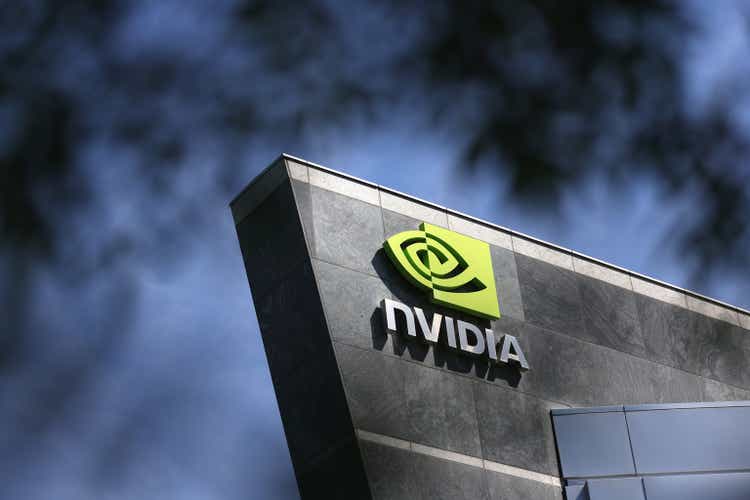Summary:
- This quarter, we actively reduced our position in our favorite company, Nvidia.
- Technology companies scale up rapidly, unconstrained by physical production capacity, but decline quicker.
- Nvidia’s dominant market share is safe for the next several years; however, what it looks like in 5-7 years is unknown.
Justin Sullivan
The following segment was excerpted from this fund letter.
Nvidia (NASDAQ:NVDA)
Like the Undertaker’s undefeated streak at WrestleMania (21-0 when he lost to Brock Lesnar), all good things must end. This quarter, we actively reduced our position in our favorite company, Nvidia. Over the past several years, I have consistently noted the concentration of the top 5 holdings in our portfolio, with NVDA comprising 26% of the last quarter’s 40%. The business, management, and outlook are nothing short of excellent. The business has a dominant market share in a rapidly growing market with competition seemingly years behind, though, fighting hard to gain share. Gross margin is expected to exceed 70% in 2024 and expand in 2025, reflecting the premium customers pay for their advanced technology. Revenue growth of 30%+ on a $50B base and a return on equity over 50%. If this isn’t the best business in the world currently, certainly it is in the top 5.
Jensen is the reason we held onto the stock despite our unease about the valuation. Jensen came to the U.S. from Thailand and was sent to a boarding school in rural Kentucky for troubled youth by his aunt and uncle, who mistook it for a prep school. When buying an ownership stake in the business, we must ask ourselves who we partner with. Are they honest? Capable? Aligned?
Honest: Listening to Jensen (while promotional) is like a breadth of fresh air. He tells you how it is. When the business looked like it was headed for failure in 2009, Jensen reduced his salary to $1.
Capable: Does the leader always have shareholder interests top of mind? Nvidia has been the GPU market leader, with no signs of relinquishing the title anytime soon. Constant reinvesting into the business has allowed this competitive advantage to deepen.
Aligned: Jensen owns ~3.5% of NVDA. Even in 2013, when we took our initial position at $3.11, and the market cap was ~$7B, the 23m shares owned, worth $260m+ compared to a $784k salary, gives a plentiful indication of his incentives. Over the 10-year holding period, we could not have been in better hands.
We substantially reduced the position during the quarter due to the extreme valuation, excessive optimism, and other market opportunities. While we believe AI is in the early stages (even though it has been around for decades), the current valuation implies that NVDA maintains a dominant market position for the foreseeable future. As Aswath Damodaran, professor at NYU, discusses, the corporate life cycle of technology companies compared to other industries is far shorter.
Technology companies scale up rapidly, unconstrained by physical production capacity, but decline quicker. The mature phase’s duration depends on the competitive advantage’s nature. For example, consumer companies such as Coca-Cola and Pepsi have long mature phases due to their brand power. The decline depends on how quickly new companies can enter the market, scale up, and attract customers. Technology companies age in dog years. One year of Procter & Gamble (PG) is different from one year at Intel (INTC). When companies generate excess profits, and in the case of NVDA, exorbitant profits, competition will come in droves. It’s not if but when NVDA will lose its market-leading position. Just a decade ago, the notion that Intel would ever be displaced in the CPU market seemed farfetched, yet, as we stand here today, it has done nothing but seed share to AMD, and more competition is coming from Nvidia and Qualcomm (QCOM). In a capitalist society, competition seeks out the highest risk-adjusted return. Nvidia’s dominant market share is safe for the next several years; however, what it looks like in 5-7 years is unknown, yet buying the stock at today’s price requires one to have a keen insight into that exact question.
We sold about 30% of the position outright and further hedged our position by selling deep-in-the-money calls expiring in 2024 (which helps reduce 2023’s tax bill) and, in some cases, sold OTM calls. Should the ITM calls get exercised, our NVDA position will be reduced by another 37%. The remaining positions are primarily held in taxable accounts, and due to already sizable capital gains taxes, we are deferring the sale of more NVDA shares until at least 2024. Should we find abundant opportunities, we would likely sell down the NVDA position further to fund the new purchases.
While in one sense, this feels like the closing of one story, it’s also the O’Keefe Stevens foray into the post-NVDA world. Over the past ten years, it’s been our most discussed position. Now, we can discuss other positions that have gone by the wayside. Furthermore, the rate rise over the past year has come at a fortuitous time. As we take time to deploy the proceeds, cash is no longer yielding 0%, but instead 5%, allowing us to deploy capital patiently.
DisclaimerThis document is for informational purposes only. O’Keefe Stevens Advisory is not providing any investment recommendations with the publishing of this document, and no firm performance data is included in this document. |
Editor’s Note: The summary bullets for this article were chosen by Seeking Alpha editors.
